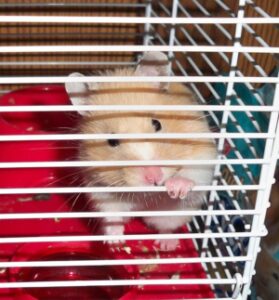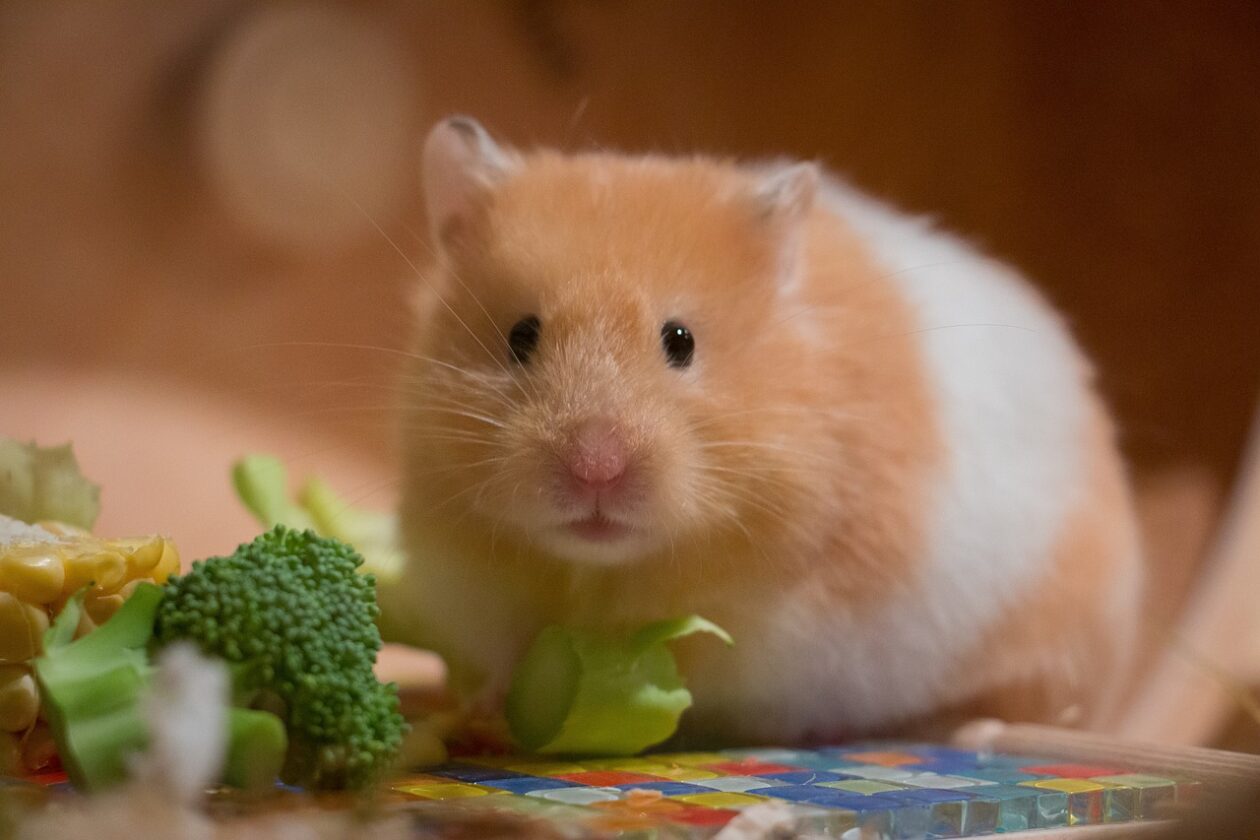When you notice an empty cage, don’t panic and think you’ll never find your hamster again. It may take 24 hours or over a week to lure your hamster from its safe hiding place, and you can do this with easy steps. Other domestic pets can be dangerous, so you must restrict a cat’s movements in the home. And don’t forget to keep external doors closed too.
There are numerous ways to track your missing hamster:
- Twine
- Flour
- Cardboard
- Foil
- Food
And when you know which room your hamster is hiding in, you need 8 simple items to catch it.
How can I prevent my hamster from going missing?
Ensure the cage is positioned somewhere safe and cannot topple off a sideboard if nudged. The safest place is the floor. We’ve had one of our cats push a hamster cage onto the floor. The door opened, and our hamster escaped. My Mum’s cat caught it, carried our hamster upstairs, and dropped it on Mum’s chest as she slept. She woke up startled to find a hamster running across the bed, and her Siamese cat sat there. Mum returned an uninjured hamster to its cage.
Another hamster escaped with its babies. We found them inside a rolled-up carpet. One baby died because it crawled between the carpet and the skirting board. The rest of the family was returned to its cage uninjured.
Check the cage door is secure and that the metal mesh is clipped securely to the base.
Don’t let your hamster exercise freely in the house. It takes seconds to lose a tiny creature. Provide boredom breakers like these dried sunflower heads, foraging experiences, cages with tunnels and different floors, and an activity wheel for exercise, and if you prefer out-of-cage time for your pet, try the Rosewood glittery activity ball. Our hamsters loved the activity ball, and it was safe for them to use around cats.
The RSPCA say hamsters live in too small cages, which are still for sale online. A hamster needs a minimum floor space of 80 x 50 cm. The cost must be factored in if you are considering buying or adopting a hamster. I found the Savic cage, correct size (80 x 50 x 50cm), two platforms, including two ladders, a 150ml drinking bottle with holder, a penthouse kit, a tunnel kit, two stainless steel bowls, 18cm exercise wheel … and a toilet with shovel and sand. It costs £85.99 but is on offer for £74.49 (October 2022). Zooplus constantly have offers, and as I receive them, I highlight them.
How to keep my lost hamster safe in my home?
As soon as you realise your hamster is missing, act immediately:
1: Close all internal doors to limit your hamster’s movement from room to room. And keep external doors closed
2: Keep dogs out of rooms. A dog won’t understand that he must not be bound around
3: Put cats upstairs. A cat is a predator of a hamster
4: Tell your family that your hamster has escaped and ask them to be careful when walking about in case your hamster is snuggled beneath a rug or between sofa cushions. At first, keep everyone from the immediate area where your hamster was last seen, as you might catch sight of him if it’s quiet. Loud noise may frighten your hamster too
5: Remove dog and cat water bowls because your hamster can climb in and drown
6: Remove any lethal mouse traps and harmful substances
7: When it is away from its comfort zone, it will be frightened and search for a safe and secure place to hide. This could be beneath cupboards, inside slippers, under the sofa or between cushions, behind the fridge, any pipework openings, or anything with a small opening your hamster can crawl into because he feels safe. Block openings or crevices on the floor (old wooden flooring) but remember your hamster may have already crawled through, so it is essential to entice them out rather than trapping them inside. That’s where food is the key
When is a hamster likely to be active?
Hamsters are nocturnal creatures. Therefore, a missing hamster will be active at night. When you go to bed or are relaxing in the lounge without noisy distractions, listen to different sounds in the home.
Remember to take the steps below in readiness for the first night. Do this before nightfall to encourage your hamster from its hiding place during the night when it’s quiet and it doesn’t sense danger.
How do I lure a hamster out of hiding?

Your hamster needs food and water. It isn’t a guarantee that your pet will return to its cage, but you can place this on the floor with fresh water and food inside
Otherwise, how can you lure your hamster out of its hiding place? Don’t forget to keep the door closed to each room- your hamster will leave clues showing which room it is.
1: Place ten sunflower seeds in a small pile in the room
2: Put flour on a tray or several saucers in each room. You can buy cheaper crockery from a charity shop. Flatten the flour as it will be easier to see if it has been walked on. Sprinkle large seeds on top – count the seeds
3: Tie food to a long piece of plain, undyed garden twine. Lay the twine in a straight line on the floor.
An example of food you can use to entice your hamster with:
- Carrot
- Nuts
- Courgette
- Broccoli
- Apple pieces
Remember to bin fresh food the following day.
4: Lay large pieces of foil in different places around each room.
5: Leave small pieces of cardboard, with even edges, in each room. Make a note of how many pieces are left in each room.
How do I know if my hamster has come out of hiding?
By keeping each door closed with the same set-up in each room, hopefully, you can establish which room your hamster is hiding in. If everything is untouched, do not give up. Also, check if possible hiding places have been blocked since your hamster went missing.
So how can you tell if your hamster has visited a room?
1: Is the small pile of seeds scattered, and how many are left?
2: Has the flour been disturbed? Is there a trail of white footprints leading to any possible hiding place?
3: Next morning, follow the twine. Hopefully, your hamster has picked up the food and taken it to its hiding place. If the food is still where you left it, or if the twine is still in a straight line, don’t give up and try again. If the twine and food have moved, or the food has been nibbled, you know your hamster is in that room even if you still do not know where the hiding place is
4: Laying several pieces of foil in each room may allow you to hear the crinkle of foil as your hamster walks over it but only if you are sitting or lying quietly in that particular room. If you were upstairs, you wouldn’t hear it. Alternatively, buy a wheel on a stand – you have more chance of hearing your furry companion with this. The Pennine wheel is £4.68 (October 2022)
Another option, if you know which room your hamster is in, is to put flour on the foil and position it near any potential hiding places, then next morning, check for footprints
5: Your hamster may decide to gnaw at the cardboard or drag small pieces back to its hiding place for bedding
6: Take a photograph of the room showing the layout of your ‘traps’ that will track your hamster. You can judge better if anything has been moved
7: Look for hamster poop!
Will my hamster return to its cage by itself?

There is a chance, especially with fresh food available.
Cages are available with a top or side door; for your hamster to get inside, you must put the cage on the floor and leave the door open.
If the cage has a side door, create a step or steps for your hamster to get inside but don’t forget it will need something to land on the other side if a high drop.
With a roof door, empty the cage, lay on its side, and set up its house, water bottle and food back inside.
How do I catch my hamster?
We were lucky to catch our hamsters. I researched online and found the following:
Something Animal has a fantastic tutorial on capturing a hamster, any other pet rodent, or an unwelcome one.
A Bucket, bin or box trap tutorial to catch your hamster:
- Use a bucket, a bin or a box. It must be tall enough to prevent your hamster from escaping when inside
- Plastic water bottle
- A spreadable treat with a powerful scent to attract your hamster. Choose a food your hamster will enjoy – for example, cream cheese, baby food, smooth peanut butter, wet dog or cat food
- Drinking straw
- A pile of books
- An old towel, folded
- Food that provides a water source
- Favourite seed mix
Method:
1: Pierce a hole through the water bottle lid and base. Thread the straw through the lid hole and out from the base
2: Lay the folded towel on the bucket’s base to provide a soft landing. Put chopped-up cucumber (hydration food) and seed mix across the towel
3: Create a secure and safe set of steps up the side of the bucket and past the rim
4: Sprinkle sunflower seeds or your hamster’s favourite treats on each step to encourage them to climb up
5: Wipe the spreadable treat around the middle section of the plastic water bottle. Now position across the top middle of the bucket, with the straw ends resting across the bucket rim. Test the bucket – does it spin around?
The outcome:
When your hamster reaches the top of the stars, the scent of the spreadable treat will encourage your hamster to reach out for it. It will spin as it touches the bottle, and your hamster should topple safely on the folded towel in the bucket.
Poppys Pets is a participant in Awin and Amazon Associate affiliate programs which compensates me for referring traffic. It is of no extra cost to you and if thinking of buying a product, please consider using my link. It\'ll earn Poppy\'s Pets a few pennies to continue to this website. Only a selection of articles and videos on this website and YouTube channel contains affiliate links. Further information: Disclaimer and Privacy Policy
Poppy’s Pets has a column in a local East Yorkshire newspaper

